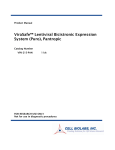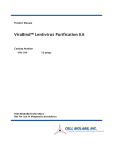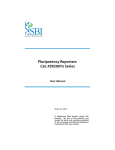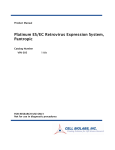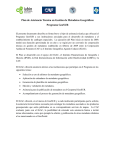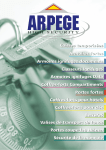Download ViraSafe™ Universal Lentiviral Expression System, Ecotropic
Transcript
Product Manual ViraSafe™ Universal Lentiviral Expression System, Ecotropic Catalog Number VPK-211-ECO 1 kit FOR RESEARCH USE ONLY Not for use in diagnostic procedures Introduction Lentivirus vector based on the human immunodeficiency virus-1 (HIV-1) has become a promising vector for gene transfer studies. The advantageous feature of lentivirus vector is the ability of gene transfer and integration into dividing and non-dividing cells. The pseudotyped envelope with vesicular stomatitis virus envelope G (VSV-G) protein broadens the target cell range. Lentiviral vectors have been shown to deliver genes to neurons, lymphocytes and macrophages, cell types that previous retrovirus vectors could not be used. Lentiviral vectors have also proven to be effective in transducing brain, liver, muscle, and retina in vivo without toxicity or immune responses. Recently, the lentivirus system is widely used to integrate siRNA efficiently in a wide variety of cell lines and primary cells both in vitro and in vivo. Lentivirus particles are produced from 293T cells through transient transfection of plasmids that encode for the components of the virion (Figure 1). Due to safety concerns regarding the infectious nature of HIV-1, recent lentiviral packaging systems have separated the viral components into 3 or 4 plasmids. However, these systems still present a small chance of generating replication-competent lentivirus upon recombination. In addition, most commercial lentiviral packaging systems provide plasmids containing the viral structure proteins in a premixed formulation, making it nearly impossible to optimize the ratio of the various plasmids for your particular experiment and host cell. Also, most commercial lentivirus transfer vectors contain promoters, antibiotic selection markers and/or reporter genes which may not be optimal or even suitable for your particular expression studies. Cell Biolabs’ ViraSafe™ Universal Lentiviral Expression System provides a much safer method to package lentivirus, while still providing high viral titers. The sequence homology with native HIV-1 has been reduced by 80-90% even compared with other commercial third-generation packaging systems. In addition, each plasmid is provided separately rather than in a packaging mixture. This allows you the flexibility to amplify individual plasmids and optimize the ratio of plasmids for your experiment. The expression vector in the ViraSafe™ Universal Lentiviral Expression System does not contain any promoter ahead of the multiple cloning sites, nor does it contain any reporter genes or antibiotic selection markers. This makes the system truly universal by allowing you to introduce your own promoter, marker or reporter that is optimal for your gene of interest or target cell. It also makes the system ideal for promoter studies. The expression vector can accommodate inserts up to 10 kb. Key Features of ViraSafe™ Lentiviral Expression System: 1. Transfer Plasmid: Reduce extent of HIV sequences to increase capability up to 10 kb and reduce likelihood of recombination between vector components. Add elements to increase titer and further improve safety. 2. Packaging Plasmid: Improve the packaging plasmid to increase performance and reduce the likelihood of recombination between vector components. a. Minimize HIV sequences – no accessory proteins, Tat or Rev, or LTRs b. Prevent overlap with vector SM by codon wobbling Gag sequences c. Boost particle production by incorporating adenovirus VAI element 3. Flexible: All vectors including packaging vectors are provided separately to allow end-user to optimize the vector ratio for maximal lentivirus production. 2 Figure 1. Lentivirus Production in 293T Cells Related Products 1. LTV-100: 293LTV Cell Line 2. LTV-200: ViraDuctin™ Lentivirus Transduction Kit 3. VPK-104: ViraBind™ Lentivirus Purification Kit 4. VPK-107: QuickTiter™ Lentivirus Titer Kit (Lentivirus-Associated HIV p24) 5. VPK-108-H: QuickTiter™ Lentivirus Quantitation Kit (HIV p24 ELISA) 6. VPK-205: ViraSafe™ Lentivirus Packaging System, Ecotropic 7. VPK-211: pSMPUW Universal Lentiviral Expression Vector (Promoterless) 3 Unique Elements of the ViraSafe™ Lentivirus Expression System Third Generation Lentivirus Expression System ViraSafe™ Lentivirus Expression System TRANSFER VECTOR ψ ψ ∆gag P CMV R U5 MCS RRE R U5 CMV R U5 SD cPPT P MCS WPRE R U5 SD X PACKAGING VECTOR #1 P gag RRE Poly(A) P gag pol RRE VA Poly(A) pol PACKAGING VECTOR #2 P P Rev Rev ENVELOPE VECTOR P Vector Name P VSVG Element cPPT Transfer Vector Transfer Vector ELEMENTS ADDED • Increased gene expression levels • • WPRE • Increased safety: prevents read-through transcription Increased viral titer: vector transcript more stable in packaging cells Increased viral titer Codon Wobble • Increased safety: reduces sequence homology Adenovirus VA • Increased viral titer WPRE Packaging Vector #1 Benefits compared to other 3rd Generation Systems Name Central Polypurine Tract Hybrid 3’ LTR Poly(A) EcoEnv VA ∆gag RRE Gag sequence Rev-Responsive Element ELEMENTS REMOVED • Increased safety: reduces sequence homology • Increased safety: reduces sequence homology Kit Components 1. pSMPUW Universal Lentiviral Expression Vector (Part No. VPK-211): One 40 µL vial at 0.25 mg/mL. The plasmid is kanamycin resistant. Note: Please see Figure 2 for important instructions on bacterial culture of this plasmid. 2. pRSV-Rev Packaging Vector (Part No. 320022): One 40 µL vial at 0.25 mg/mL. 3. pCMV-Eco Envelope Vector (Part No. 320026): One 40 µL vial at 0.25 mg/mL. 4. pCgpV Packaging Vector (Part No. 320024): One 40 µL vial at 0.25 mg/mL. 5. pSMPUW-LacZ Control Vector (Part No. 320025): One 40 µL vial at 0.25 mg/mL containing a nuclear localized LacZ driven by MND retroviral LTR promoter. The plasmid is kanamycin resistant. Note: Please see Figure 2 for important instructions on bacterial culture of this plasmid. Materials Not Supplied 1. 293T cells: we recommend 293LTV Cell Line (Cat. # LTV-100) for high titer production of lentivirus. 2. Cell Culture Medium 3. Transfection Reagents Storage Upon receipt, store all other kit components at -20ºC until their expiration dates. Safety Considerations Remember that you will be working with samples containing infectious virus. Follow the recommended NIH guidelines for all materials containing BSL-2 organisms. The ViraSafe™ Universal Lentiviral Expression System is designed to minimize the chance of generating replicationcompetent lentivirus, but precautions should still be taken to avoid direct contact with viral supernatants. Preparation of pSMPUW Expression Vector pSMPUW Universal Expression Vector does not contain a promoter ahead of the multiple cloning sites, nor does it contain any reporter genes or antibiotic selection markers. You must clone a promoter into the vector along with your gene of interest. An antibiotic selection marker and/or reporter gene may also be cloned into the vector (optional). MCS: GGGGGATCCGCGGAATTCGTCGATATCAGCGTCGACAAT BamHI EcoRI EcoRV SalI Figure 2: pSMPUW Lentiviral Expression Vector (4632 bp, Kanamycin-resistant). EcoRI/XhoI Digestion: 1251 bp + 3381 bp. Note: Bacterial culture of pSMPUW vectors should be done in medium containing 10 µg/mL Kanamycin. For maximal plasmid yield and quality, we recommend Stbl3 endoA1+ competent cells (Invitrogen) and treatment with alkaline proteinase (Promega #A1441 or Sigma #P8038) for 4-5 min using 10 units of proteinase per mL of bacterial lysate before adding neutralization solution. RSV Rev Figure 3: pRSV-Rev Packaging Vector (4180 bp, Ampicillin-resistant). EcoRI Digestion: 300 bp + 3880 bp CMV EcoEnv Figure 4: pCMV-Eco Envelop Vector (6763 bp, Ampicillin-resistant). BamHI Digestion: 777 bp + 5986 bp. CMV gag RRE VA Poly(A) pol Figure 5: pCgpV Packaging Vector (9118 bp, Ampicillin-resistant). Pst I Digestion: 927 bp + 1424 bp + 6767 bp. 6 Lentivirus Production 1. One day before transfection, plate sufficient 293T cells or 293LTV cells (Cat. # LTV-100) to achieve 70-80% confluence on the day of transfection. 2. Transfect cells by Calcium Phosphate or other transfection reagents. Note: We suggest transfecting cells with FuGENE® Transfection Reagent (Roche Applied Science) or Lipofectamine™ Plus (Invitrogen). We recommend the ratio of vectors at 3:1:1:1 (pSMPUW: pCMV-Eco:pRSV-REV:pCgpV). 3. Harvest lentiviral supernatant 36-72 hours after transfection. Supernatant can be harvested 2 or 3 times, every 12 hours. Keep it at 4ºC over the collecting period. 4. Pool the collected supernatants, centrifuge 5 minutes at 1500 rpm to remove cell debris and filtrate on 0.22 µm. 5. Supernatants can be used directly or purified/concentrated if needed. For long term storage, store supernatant at -80ºC in aliquots. Post-Packaging Considerations Packaging your lentivirus is only the first step to ensuring successful expression of your gene. The following steps should be considered prior to infection of your host cell: 1. Concentration and purification of your lentivirus: Because of the latent nature of lentivirus, it is imperative that your virus be highly concentrated before infecting your host cell. Also, impurities from your viral supernatant can decrease the efficiency of infection. We recommend using Cell Biolabs’ ViraBind™ Lentivirus Concentration and Purification Kit (Catalog # VPK-090). 2. Measure the titer of your lentivirus: This is an important step to ensure consistent viral transduction into your host cell. However, QPCR or stable clone counting can take as much as 1-2 weeks to perform. Traditional p24 ELISA kits can greatly overestimate your lentiviral titer. Our advanced p24 ELISA, QuickTiter™ Lentivirus Titer Kit (Catalog # VPK-107), uses exclusive technology that eliminates free p24 from your supernatant, giving you much more accurate lentiviral titers. Results are obtained in 6-18 hours. 3. Use transduction reagents to increase infection efficiency: Many cells are difficult to infect with lentivirus, and without supplemental reagents transduction efficiencies can be low. Reagents such as Polybrene® can help, but are often insufficient. Cell Biolabs’ proprietary reagents in our ViraDuctin™ Lentivirus Transduction Kit (Catalog # LTV-200) form a super-complex with your virus to increase transduction efficiencies by promoting virus and cell interaction. 7 Appendix pSMPUW Plasmid Sequence Pink: 5’ CMV/LTR, ψ, cPPT Purple: MCS Brown: WPRE Orange: 3’ LTR Blue: Kanamycin Resistance gene ACTAGTCGGGGTCATTAGTTCATAGCCCATATATGGAGTTCCGCGTTACATAACTTACGGTAAATGGCCCGCCTGGCTGACCGCCCAACGACCCCCGCCCATT GACGTCAATAATGACGTATGTTCCCATAGTAACGCCAATAGGGACTTTCCATTGACGTCAATGGGTGGAGTATTTACGGTAAACTGCCCACTTGGCAGTACAT CAAGTGTATCATATGCCAAGTACGCCCCCTATTGACGTCAATGACGGTAAATGGCCCGCCTGGCATTATGCCCAGTACATGACCTTATGGGACTTTCCTACTT GGCAGTACATCTACGTATTAGTCATCGCTATTACCATGGTGATGCGGTTTTGGCAGTACATCAATGGGCGTGGATAGCGGTTTGACTCACGGGGATTTCCAAG TCTCCACCCCATTGACGTCAATGGGAGTTTGTTTTGGCACCAAAATCAACGGGACTTTCCAAAATGTCGTAACAACTCCGCCCCATTGACGCAAATGGGCGGT AGGCGTGTACGGTGGGAGGTCTATATAAGCAGAGCTGGTTTAGTGAACCGGGTCTCTCTGGTTAGACCAGATTTGAGCCTGGGAGCTCTCTGGCTAACTAGGG AACCCACTGCTTAAGCCTCAATAAAGCTTGCCTTGAGTGCTTCAAGTAGTGTGTGCCCGTCTGTTGTGTGACTCTGGTAACTAGAGATCCCTCAGACCCTTTT AGTCAGTGTGGAAAATCTCTAGCAGTGGCGCCCGAACAGGGACCTGAAAGCGAAAGGGAAACCAGAGGAGCTCTCTCGACGCAGGACTCGGCTTGCTGAAGCG CGCACGGCAAGAGGCGAGGGGCGGCGACTGCAGAGTACGCCAAAATTTTGACTAGCGGAGGCTAGAAGGAGAGAGATGGGTGCGAGAGCGTCAGTATTAAGCG GGGGAAAATAGCGGCCGCCACAATTTTAAAAGAAAAGGGGGGATTGGGGGGTACAGTGCAGGGGAAAGAATAGTAGACATAATAGCAACAGACATACAAACTA AAGAATTACAAAAACAAATTACAAAAATTCAAATTTTCGGGGGATCCGCGGAATTCGTCGATATCAGCGTCGACAATCAACCTCTGGATTACAAAATTTGTGA AAGATTGACTGGTATTCTTAACTATGTTGCTCCTTTTACGCTATGTGGATACGCTGCTTTAATGCCTTTGTATCATGCTATTGCTTCCCGTATGGCTTTCATT TTCTCCTCCTTGTATAAATCCTGGTTGCTGTCTCTTTATGAGGAGTTGTGGCCCGTTGTCAGGCAACGTGGCGTGGTGTGCACTGTGTTTGCTGACGCAACCC CCACTGGTTGGGGCATTGCCACCACCTGTCAGCTCCTTTCCGGGACTTTCGCTTTCCCCCTCCCTATTGCCACGGCGGAACTCATCGCCGCCTGCCTTGCCCG CTGCTGGACAGGGGCTCGGCTGTTGGGCACTGACAATTCCGTGGTGTTGTCGGGGAAATCATCGTCCTTTCCTTGGCTGCTCGCCTGTGTTGCCACCTGGATT CTGCGCGGGACGTCCTTCTGCTACGTCCCTTCGGCCCTCAATCCAGCGGACCTTCCTTCCCGCGGCCTGCTGCCGGCTCTGCGGCCTCTTCCGCGTCTTCGCC TTCGCCCTCAGACGAGTCGGATCTCCCTTTGGGCCGCCTCCCCGCTTAGTACTGGTACCTTTAAGACCAATGACTTACAAGGCAGCTGTAGATCTTAGCCACT TTTTAAAAGAAAAGGGGGGACTGGAAGGGCTAATTCACTCCCAACGAAGACAAGATTCCGGAATTTATTTGTGAAATTTGTGATGCTATTGCTTTATTTGTAA ACCGGTGCAGCTGCTTTTTGCCTGTACTGGGTCTCTCTGGTTAGACCAGATCTGAGCCTGGGAGCTCTCTGGCTAACTAGGGAACCCACTGCTTAAGCCTCAA TAAAGCTTGCCTTGAGTGCTTCAAGTAGTGTGTGCCCGTCTGTTGTGTGACTCTGGTAACTAGAGATCCCTCAGACCCTTTTAGTCAGTGTGGAAAATCTCTA GCATCTAGAGTATGCAAAGCATGCATCTCAATTAGTCAGCAACCAGGTGTGGAAAGTCCCCAGGCTCCCCAGCAGGCAGAAGTATGCAAAGCATGCATCTCAA TTAGTCAGCAACCATAGTCCCGCCCCTAACTCCGCCCATCCCGCCCCTAACTCCGCCCAGTTCCGCCCATTCTCCGCCCCATGGCTGACTAATTTTTTTTATT TATGCAGAGGCCGAGGCCGCCTCGGCCTCTGAGCTATTCCAGAAGTAGTGAGGAGGCTTTTTTGGAGGCCTAGGCTAGAGATCATAATCAGCCATACCACATT TGTAGAGGTTTTACTTGCTTTAAAAAACCTCCCACACCTCCCCCTGAACCTGAAACATAAAATGAATGCAATTGTTGTTGTTAACTTGTTTATTGCAGCTTAT AATGGTTACAAATAAAGCAATAGCATCACAAATTTCACAAATAAAGCATTTTTTTCACTGCATTCTAGTTGTGGTTTGTCCAAACTCATCAATGTATCTTATC ATGTCTGCTAGCCGGGCTTTTTTTTCTTAGGCCTTCTTCCGCTTCCTCGCTCACTGACTCGCTGCGCTCGGTCGTTCGGCTGCGGCGAGCGGTATCAGCTCAC TCAAAGGCGGTAATACGGTTATCCACAGAATCAGGGGATAACGCAGGAAAGAACATGTGAGCAAAAGGCCAGCAAAAGGCCAGGAACCGTAAAAAGGCCGCGT TGCTGGCGTTTTTCCATAGGCTCCGCCCCCCTGACGAGCATCACAAAAATCGACGCTCAAGTCAGAGGTGGCGAAACCCGACAGGACTATAAAGATACCAGGC GTTTCCCCCTGGAAGCTCCCTCGTGCGCTCTCCTGTTCCGACCCTGCCGCTTACCGGATACCTGTCCGCCTTTCTCCCTTCGGGAAGCGTGGCGCTTTCTCAT AGCTCACGCTGTAGGTATCTCAGTTCGGTGTAGGTCGTTCGCTCCAAGCTGGGCTGTGTGCACGAACCCCCCGTTCAGCCCGACCGCTGCGCCTTATCCGGTA ACTATCGTCTTGAGTCCAACCCGGTAAGACACGACTTATCGCCACTGGCAGCAGCCACTGGTAACAGGATTAGCAGAGCGAGGTATGTAGGCGGTGCTACAGA GTTCTTGAAGTGGTGGCCTAACTACGGCTACACTAGAAGAACAGTATTTGGTATCTGCGCTCTGCTGAAGCCAGTTACCTTCGGAAAAAGAGTTGGTAGCTCT TGATCCGGCAAACAAACCACCGCTGGTAGCGGTGGTTTTTTTGTTTGCAAGCAGCAGATTACGCGCAGAAAAAAAGGATCTCAAGAAGATCCTTTGATCTTTT CTACGGGGTCTGACGCTCAGTGGAACGAAAACTCACGTTAAGGGATTTTGGTCATGAGATTATCAAAAAGGATCTTCACCTAGATCCTTTTAAATTAAAAATG AAGTTTTAAATCAATCTAAAGTATATATGAGTAAACTTGGTCTGACAGTTACCAATGCTTAATCAGTGAGGCACCTATCTCAGCGATCTGTCTATTTCGTTCA TCCATAGTTGCCTGACTCCTGCGCAGTCCAAAAAAAAAGGCTCCAAAAGGAGCCTTTAATTGTATCGGTGGGCCCTTAGAAAAACTCATCGAGCATCAAATGA AACTGCAATTTATTCATATCAGGATTATCAATACCATATTTTTGAAAAAGCCGTTTCTGTAATGAAGGAGAAAACTCACCGAGGCAGTTCCATAGGATGGCAA GATCCTGGTATCGGTCTGCGATTCCGACTCGTCCAACATCAATACAACCTATTAATTTCCCCTCGTCAAAAATAAGGTTATCAAGTGAGAAATCACCATGAGT GACGACTGAATCCGGTGAGAATGGCAAAAGCTTATGCATTTCTTTCCAGACTTGTTCAACAGGCCAGCCATTACGCTCGTCATCAAAATCACTCGCATCAACC AAACCGTTATTCATTCGTGATTGCGCCTGAGCGAGACGAAATACGCGATCGCTGTTAAAAGGACAATTACAAACAGGAATCGAATGCAACCGGCGCAGGAACA CTGCCAGCGCATCAACAATATTTTCACCTGAATCAGGATATTCTTCTAATACCTGGAATGCTGTTTTCCCGGGGATCGCAGTGGTGAGTAACCATGCATCATC AGGAGTACGGATAAAATGCTTGATGGTCGGAAGAGGCATAAATTCCGTCAGCCAGTTTAGTCTGACCATCTCATCTGTAACATCATTGGCAACGCTACCTTTG CCATGTTTCAGAAACAACTCTGGCGCATCGGGCTTCCCATACAATCGATAGATTGTCGCACCTGATTGCCCGACATTATCGCGAGCCCATTTATACCCATATA AATCAGCATCCATGTTGGAATTTAATCGCGGCCTCGAGCAAGACGTTTCCCGTTGAATATGGCTCATAACACCCCTTGTATTACTGTTTATGTAAGCAGACAG TTTTATTGTTCATGATGATATATTTTTATCTTGTGCAATGTAACATCAGAGATTTTGAGACACAACGTGGTTTAAACAAATAGTCAAAAGCCTCCGGCG 8 References 1. Chen, M. et al. (2002). Nature Genetics 32(4): 670-675. 2. Naldini, L., U. Blomer, P. Gallay, D. Ory, R. Mulligan, F. H. Gage, I. M. Verma, and D. Trono (1996) Science 272:263-267. 3. Verma, I. M., and N. Somia (1997) Nature 389:239-242 4. Kahl C. A., Marsh J., Fyffe J., Sanders D. A., and K. Cornetta (2004) J Virol. 78:1421-30. 5. White S. M., Renda M., Nam N. Y., Klimatcheva E., Zhu Y., Fisk J., Halterman M., Rimel B. J., Federoff H., Pandya S., Rosenblatt J. D., and V. Planelles (1999) J Virol. 73:2832-40. 6. Kafri T., van Praag H., Ouyang L., Gage F. H., and I. M. Verma (1999) J Virol. 73:576-84. Notice to Purchaser This product is sold for research and development purposes only and is not to be incorporated into products for resale without written permission from Cell Biolabs. The patented technology is covered by a license from CHLA and University of Southern California. By the use of this product you accept the terms and conditions of all applicable Limited Use Label Licenses. You may contact our Business Development department at [email protected] for information on sublicensing this technology. Warranty These products are warranted to perform as described in their labeling and in Cell Biolabs literature when used in accordance with their instructions. THERE ARE NO WARRANTIES THAT EXTEND BEYOND THIS EXPRESSED WARRANTY AND CELL BIOLABS DISCLAIMS ANY IMPLIED WARRANTY OF MERCHANTABILITY OR WARRANTY OF FITNESS FOR PARTICULAR PURPOSE. CELL BIOLABS’ sole obligation and purchaser’s exclusive remedy for breach of this warranty shall be, at the option of CELL BIOLABS, to repair or replace the products. In no event shall CELL BIOLABS be liable for any proximate, incidental or consequential damages in connection with the products. Contact Information Cell Biolabs, Inc. 7758 Arjons Drive San Diego, CA 92126 Worldwide: +1 858-271-6500 USA Toll-Free: 1-888-CBL-0505 E-mail: [email protected] www.cellbiolabs.com 2009-2015: Cell Biolabs, Inc. - All rights reserved. No part of these works may be reproduced in any form without permissions in writing. 9









